System Analysis and Design
VerifiedAdded on 2023/06/03
|11
|2447
|356
AI Summary
This report discusses the New Access project of Headspace, which aims to improve the management of data for mentally ill patients. It covers the non-functional requirements, cloud-based solutions, and suitable SDLC approach for the project. The report recommends the predictive SDLC approach for the project.
Contribute Materials
Your contribution can guide someone’s learning journey. Share your
documents today.

Running head: SYSTEM ANALYSIS AND DESIGN
System Analysis and Design
Name of the Student
Name of the University
Author’s Note:
System Analysis and Design
Name of the Student
Name of the University
Author’s Note:
Secure Best Marks with AI Grader
Need help grading? Try our AI Grader for instant feedback on your assignments.
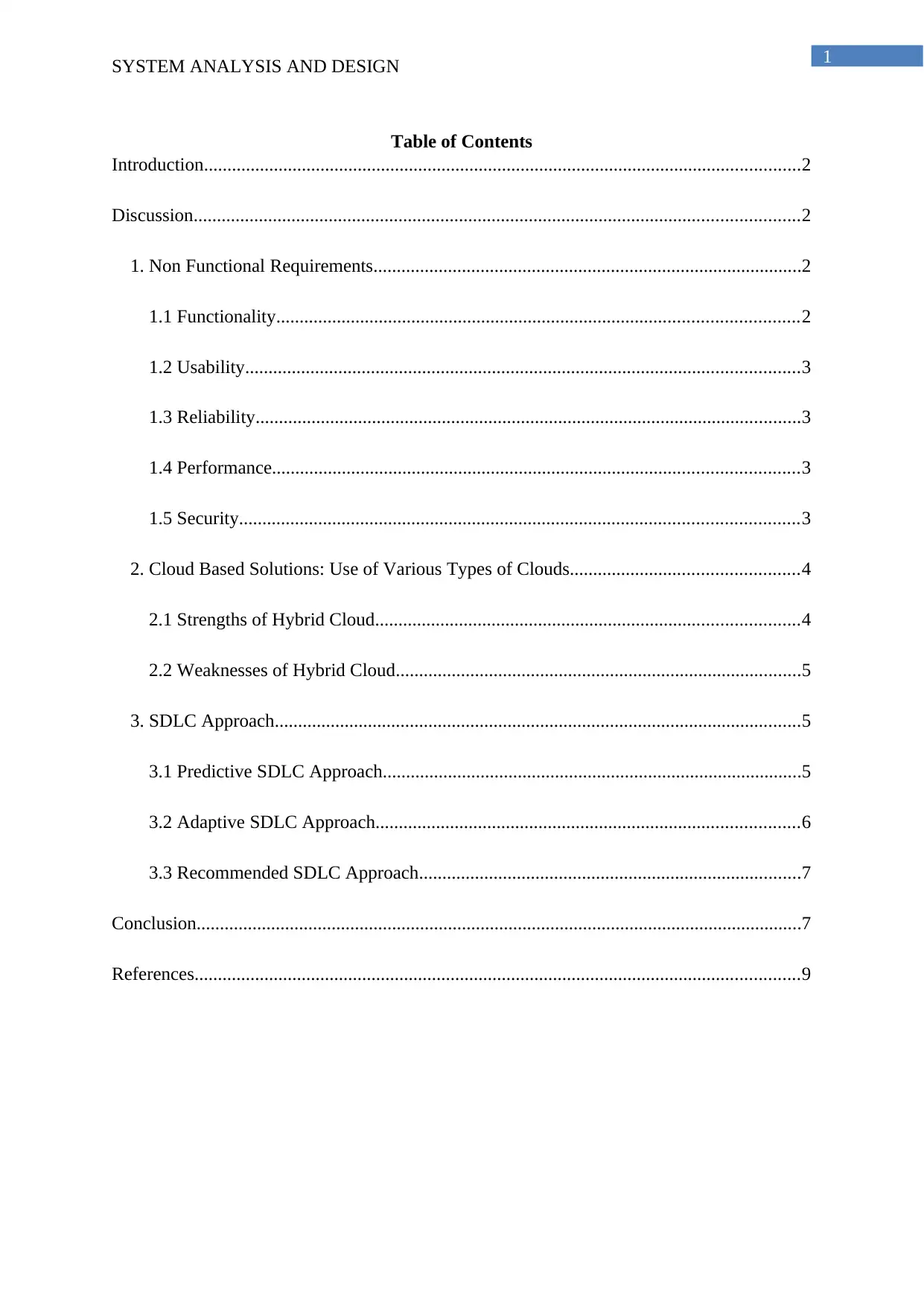
1
SYSTEM ANALYSIS AND DESIGN
Table of Contents
Introduction................................................................................................................................2
Discussion..................................................................................................................................2
1. Non Functional Requirements............................................................................................2
1.1 Functionality................................................................................................................2
1.2 Usability.......................................................................................................................3
1.3 Reliability.....................................................................................................................3
1.4 Performance.................................................................................................................3
1.5 Security........................................................................................................................3
2. Cloud Based Solutions: Use of Various Types of Clouds.................................................4
2.1 Strengths of Hybrid Cloud...........................................................................................4
2.2 Weaknesses of Hybrid Cloud.......................................................................................5
3. SDLC Approach.................................................................................................................5
3.1 Predictive SDLC Approach..........................................................................................5
3.2 Adaptive SDLC Approach...........................................................................................6
3.3 Recommended SDLC Approach..................................................................................7
Conclusion..................................................................................................................................7
References..................................................................................................................................9
SYSTEM ANALYSIS AND DESIGN
Table of Contents
Introduction................................................................................................................................2
Discussion..................................................................................................................................2
1. Non Functional Requirements............................................................................................2
1.1 Functionality................................................................................................................2
1.2 Usability.......................................................................................................................3
1.3 Reliability.....................................................................................................................3
1.4 Performance.................................................................................................................3
1.5 Security........................................................................................................................3
2. Cloud Based Solutions: Use of Various Types of Clouds.................................................4
2.1 Strengths of Hybrid Cloud...........................................................................................4
2.2 Weaknesses of Hybrid Cloud.......................................................................................5
3. SDLC Approach.................................................................................................................5
3.1 Predictive SDLC Approach..........................................................................................5
3.2 Adaptive SDLC Approach...........................................................................................6
3.3 Recommended SDLC Approach..................................................................................7
Conclusion..................................................................................................................................7
References..................................................................................................................................9
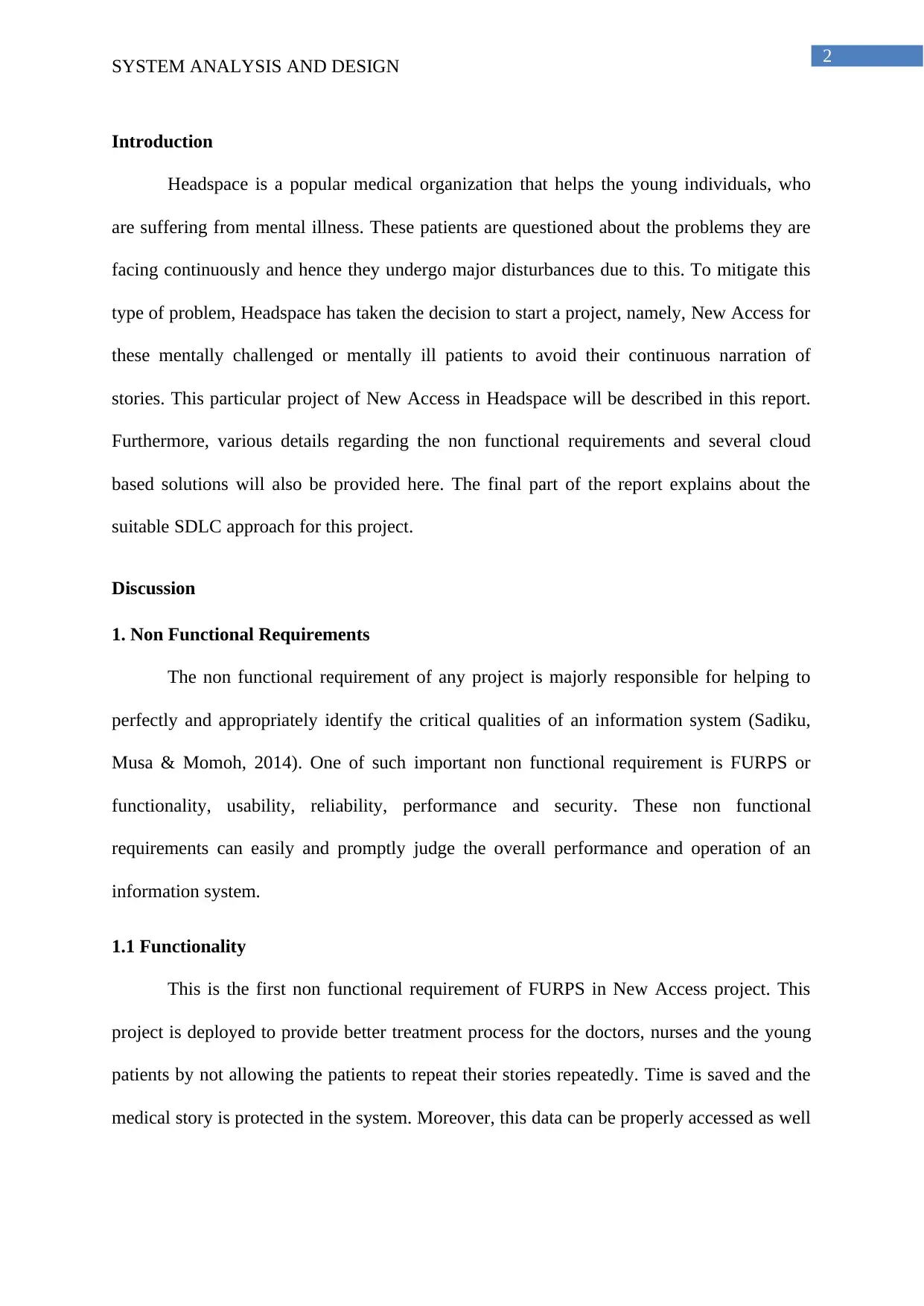
2
SYSTEM ANALYSIS AND DESIGN
Introduction
Headspace is a popular medical organization that helps the young individuals, who
are suffering from mental illness. These patients are questioned about the problems they are
facing continuously and hence they undergo major disturbances due to this. To mitigate this
type of problem, Headspace has taken the decision to start a project, namely, New Access for
these mentally challenged or mentally ill patients to avoid their continuous narration of
stories. This particular project of New Access in Headspace will be described in this report.
Furthermore, various details regarding the non functional requirements and several cloud
based solutions will also be provided here. The final part of the report explains about the
suitable SDLC approach for this project.
Discussion
1. Non Functional Requirements
The non functional requirement of any project is majorly responsible for helping to
perfectly and appropriately identify the critical qualities of an information system (Sadiku,
Musa & Momoh, 2014). One of such important non functional requirement is FURPS or
functionality, usability, reliability, performance and security. These non functional
requirements can easily and promptly judge the overall performance and operation of an
information system.
1.1 Functionality
This is the first non functional requirement of FURPS in New Access project. This
project is deployed to provide better treatment process for the doctors, nurses and the young
patients by not allowing the patients to repeat their stories repeatedly. Time is saved and the
medical story is protected in the system. Moreover, this data can be properly accessed as well
SYSTEM ANALYSIS AND DESIGN
Introduction
Headspace is a popular medical organization that helps the young individuals, who
are suffering from mental illness. These patients are questioned about the problems they are
facing continuously and hence they undergo major disturbances due to this. To mitigate this
type of problem, Headspace has taken the decision to start a project, namely, New Access for
these mentally challenged or mentally ill patients to avoid their continuous narration of
stories. This particular project of New Access in Headspace will be described in this report.
Furthermore, various details regarding the non functional requirements and several cloud
based solutions will also be provided here. The final part of the report explains about the
suitable SDLC approach for this project.
Discussion
1. Non Functional Requirements
The non functional requirement of any project is majorly responsible for helping to
perfectly and appropriately identify the critical qualities of an information system (Sadiku,
Musa & Momoh, 2014). One of such important non functional requirement is FURPS or
functionality, usability, reliability, performance and security. These non functional
requirements can easily and promptly judge the overall performance and operation of an
information system.
1.1 Functionality
This is the first non functional requirement of FURPS in New Access project. This
project is deployed to provide better treatment process for the doctors, nurses and the young
patients by not allowing the patients to repeat their stories repeatedly. Time is saved and the
medical story is protected in the system. Moreover, this data can be properly accessed as well
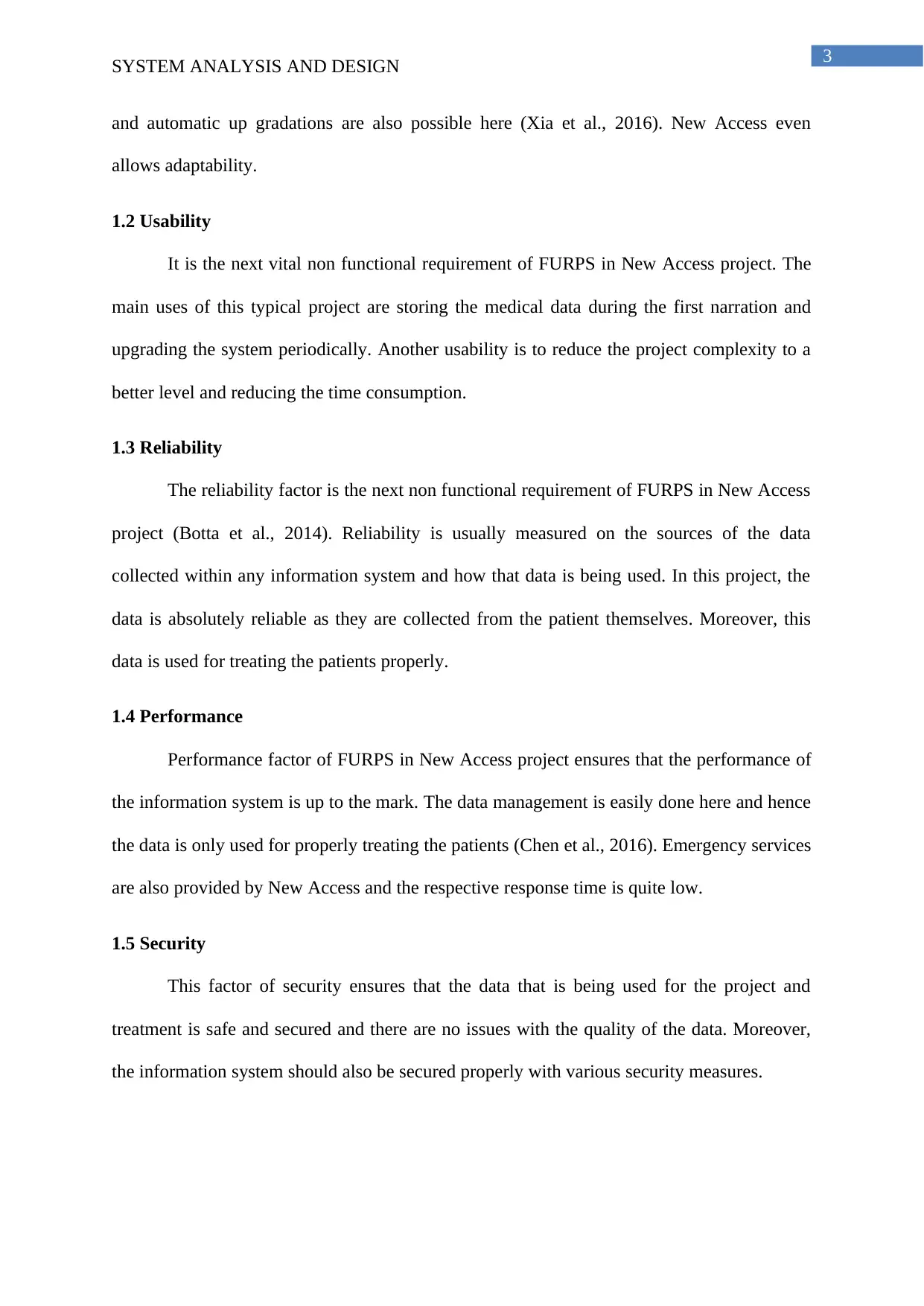
3
SYSTEM ANALYSIS AND DESIGN
and automatic up gradations are also possible here (Xia et al., 2016). New Access even
allows adaptability.
1.2 Usability
It is the next vital non functional requirement of FURPS in New Access project. The
main uses of this typical project are storing the medical data during the first narration and
upgrading the system periodically. Another usability is to reduce the project complexity to a
better level and reducing the time consumption.
1.3 Reliability
The reliability factor is the next non functional requirement of FURPS in New Access
project (Botta et al., 2014). Reliability is usually measured on the sources of the data
collected within any information system and how that data is being used. In this project, the
data is absolutely reliable as they are collected from the patient themselves. Moreover, this
data is used for treating the patients properly.
1.4 Performance
Performance factor of FURPS in New Access project ensures that the performance of
the information system is up to the mark. The data management is easily done here and hence
the data is only used for properly treating the patients (Chen et al., 2016). Emergency services
are also provided by New Access and the respective response time is quite low.
1.5 Security
This factor of security ensures that the data that is being used for the project and
treatment is safe and secured and there are no issues with the quality of the data. Moreover,
the information system should also be secured properly with various security measures.
SYSTEM ANALYSIS AND DESIGN
and automatic up gradations are also possible here (Xia et al., 2016). New Access even
allows adaptability.
1.2 Usability
It is the next vital non functional requirement of FURPS in New Access project. The
main uses of this typical project are storing the medical data during the first narration and
upgrading the system periodically. Another usability is to reduce the project complexity to a
better level and reducing the time consumption.
1.3 Reliability
The reliability factor is the next non functional requirement of FURPS in New Access
project (Botta et al., 2014). Reliability is usually measured on the sources of the data
collected within any information system and how that data is being used. In this project, the
data is absolutely reliable as they are collected from the patient themselves. Moreover, this
data is used for treating the patients properly.
1.4 Performance
Performance factor of FURPS in New Access project ensures that the performance of
the information system is up to the mark. The data management is easily done here and hence
the data is only used for properly treating the patients (Chen et al., 2016). Emergency services
are also provided by New Access and the respective response time is quite low.
1.5 Security
This factor of security ensures that the data that is being used for the project and
treatment is safe and secured and there are no issues with the quality of the data. Moreover,
the information system should also be secured properly with various security measures.
Secure Best Marks with AI Grader
Need help grading? Try our AI Grader for instant feedback on your assignments.
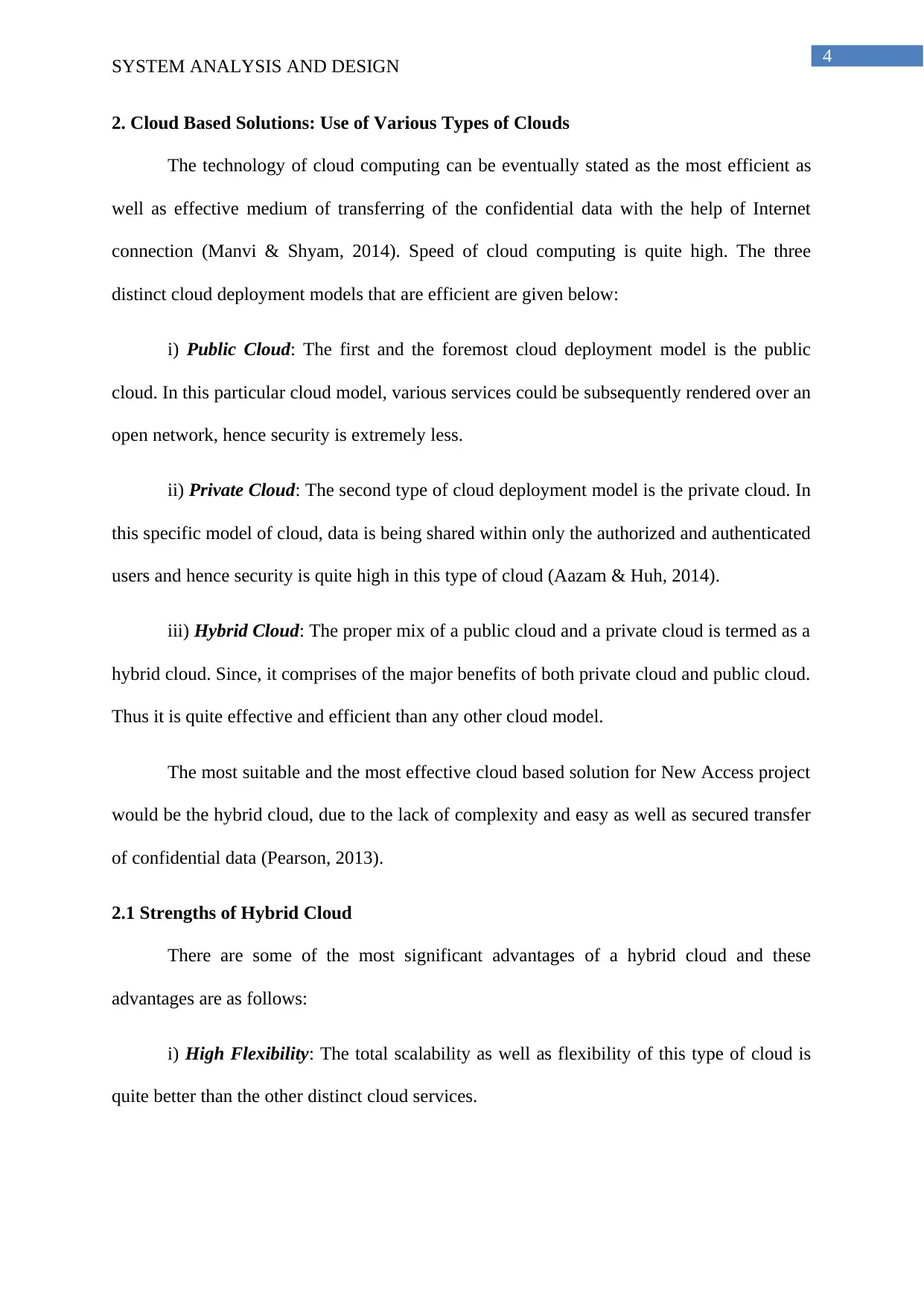
4
SYSTEM ANALYSIS AND DESIGN
2. Cloud Based Solutions: Use of Various Types of Clouds
The technology of cloud computing can be eventually stated as the most efficient as
well as effective medium of transferring of the confidential data with the help of Internet
connection (Manvi & Shyam, 2014). Speed of cloud computing is quite high. The three
distinct cloud deployment models that are efficient are given below:
i) Public Cloud: The first and the foremost cloud deployment model is the public
cloud. In this particular cloud model, various services could be subsequently rendered over an
open network, hence security is extremely less.
ii) Private Cloud: The second type of cloud deployment model is the private cloud. In
this specific model of cloud, data is being shared within only the authorized and authenticated
users and hence security is quite high in this type of cloud (Aazam & Huh, 2014).
iii) Hybrid Cloud: The proper mix of a public cloud and a private cloud is termed as a
hybrid cloud. Since, it comprises of the major benefits of both private cloud and public cloud.
Thus it is quite effective and efficient than any other cloud model.
The most suitable and the most effective cloud based solution for New Access project
would be the hybrid cloud, due to the lack of complexity and easy as well as secured transfer
of confidential data (Pearson, 2013).
2.1 Strengths of Hybrid Cloud
There are some of the most significant advantages of a hybrid cloud and these
advantages are as follows:
i) High Flexibility: The total scalability as well as flexibility of this type of cloud is
quite better than the other distinct cloud services.
SYSTEM ANALYSIS AND DESIGN
2. Cloud Based Solutions: Use of Various Types of Clouds
The technology of cloud computing can be eventually stated as the most efficient as
well as effective medium of transferring of the confidential data with the help of Internet
connection (Manvi & Shyam, 2014). Speed of cloud computing is quite high. The three
distinct cloud deployment models that are efficient are given below:
i) Public Cloud: The first and the foremost cloud deployment model is the public
cloud. In this particular cloud model, various services could be subsequently rendered over an
open network, hence security is extremely less.
ii) Private Cloud: The second type of cloud deployment model is the private cloud. In
this specific model of cloud, data is being shared within only the authorized and authenticated
users and hence security is quite high in this type of cloud (Aazam & Huh, 2014).
iii) Hybrid Cloud: The proper mix of a public cloud and a private cloud is termed as a
hybrid cloud. Since, it comprises of the major benefits of both private cloud and public cloud.
Thus it is quite effective and efficient than any other cloud model.
The most suitable and the most effective cloud based solution for New Access project
would be the hybrid cloud, due to the lack of complexity and easy as well as secured transfer
of confidential data (Pearson, 2013).
2.1 Strengths of Hybrid Cloud
There are some of the most significant advantages of a hybrid cloud and these
advantages are as follows:
i) High Flexibility: The total scalability as well as flexibility of this type of cloud is
quite better than the other distinct cloud services.
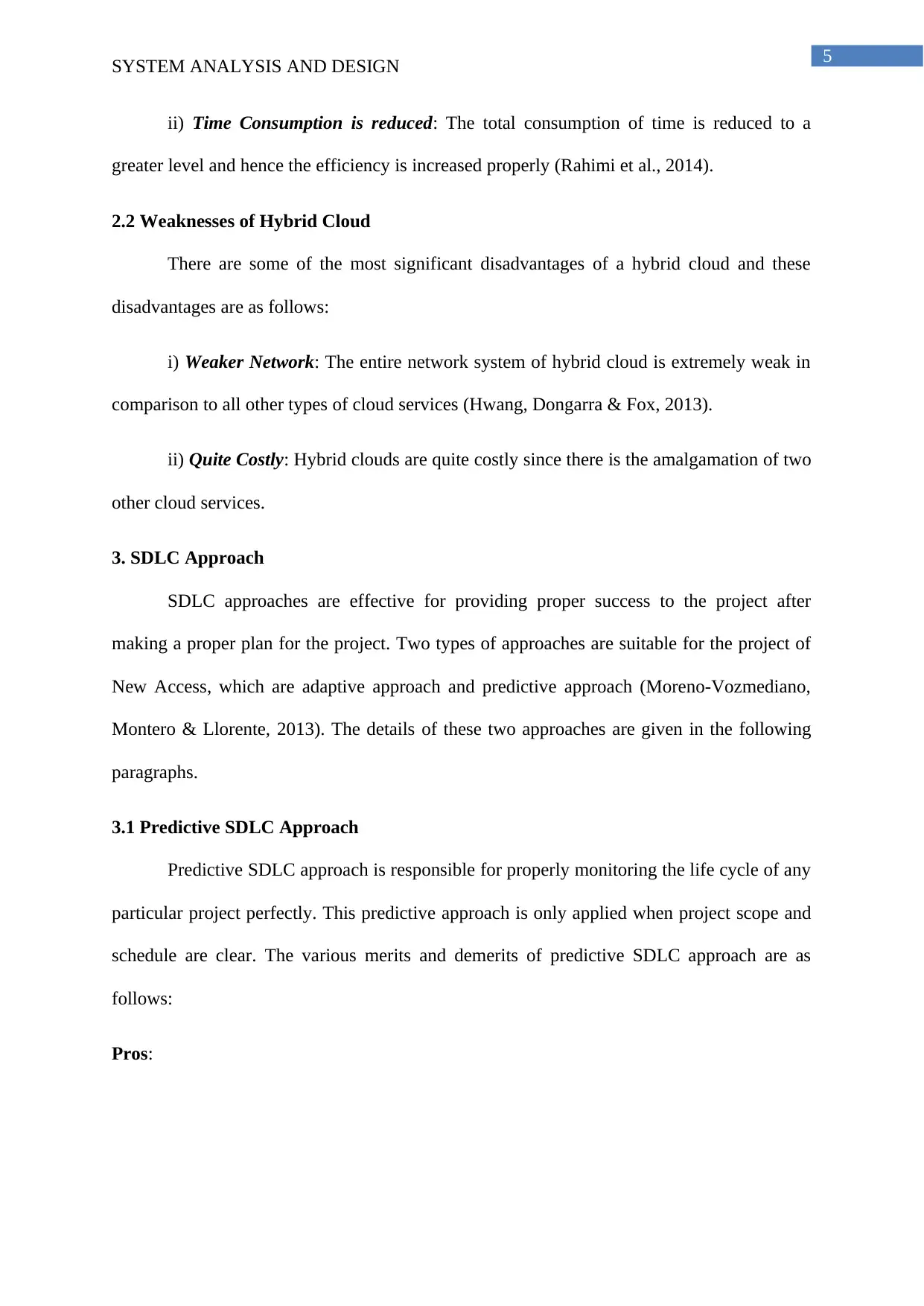
5
SYSTEM ANALYSIS AND DESIGN
ii) Time Consumption is reduced: The total consumption of time is reduced to a
greater level and hence the efficiency is increased properly (Rahimi et al., 2014).
2.2 Weaknesses of Hybrid Cloud
There are some of the most significant disadvantages of a hybrid cloud and these
disadvantages are as follows:
i) Weaker Network: The entire network system of hybrid cloud is extremely weak in
comparison to all other types of cloud services (Hwang, Dongarra & Fox, 2013).
ii) Quite Costly: Hybrid clouds are quite costly since there is the amalgamation of two
other cloud services.
3. SDLC Approach
SDLC approaches are effective for providing proper success to the project after
making a proper plan for the project. Two types of approaches are suitable for the project of
New Access, which are adaptive approach and predictive approach (Moreno-Vozmediano,
Montero & Llorente, 2013). The details of these two approaches are given in the following
paragraphs.
3.1 Predictive SDLC Approach
Predictive SDLC approach is responsible for properly monitoring the life cycle of any
particular project perfectly. This predictive approach is only applied when project scope and
schedule are clear. The various merits and demerits of predictive SDLC approach are as
follows:
Pros:
SYSTEM ANALYSIS AND DESIGN
ii) Time Consumption is reduced: The total consumption of time is reduced to a
greater level and hence the efficiency is increased properly (Rahimi et al., 2014).
2.2 Weaknesses of Hybrid Cloud
There are some of the most significant disadvantages of a hybrid cloud and these
disadvantages are as follows:
i) Weaker Network: The entire network system of hybrid cloud is extremely weak in
comparison to all other types of cloud services (Hwang, Dongarra & Fox, 2013).
ii) Quite Costly: Hybrid clouds are quite costly since there is the amalgamation of two
other cloud services.
3. SDLC Approach
SDLC approaches are effective for providing proper success to the project after
making a proper plan for the project. Two types of approaches are suitable for the project of
New Access, which are adaptive approach and predictive approach (Moreno-Vozmediano,
Montero & Llorente, 2013). The details of these two approaches are given in the following
paragraphs.
3.1 Predictive SDLC Approach
Predictive SDLC approach is responsible for properly monitoring the life cycle of any
particular project perfectly. This predictive approach is only applied when project scope and
schedule are clear. The various merits and demerits of predictive SDLC approach are as
follows:
Pros:
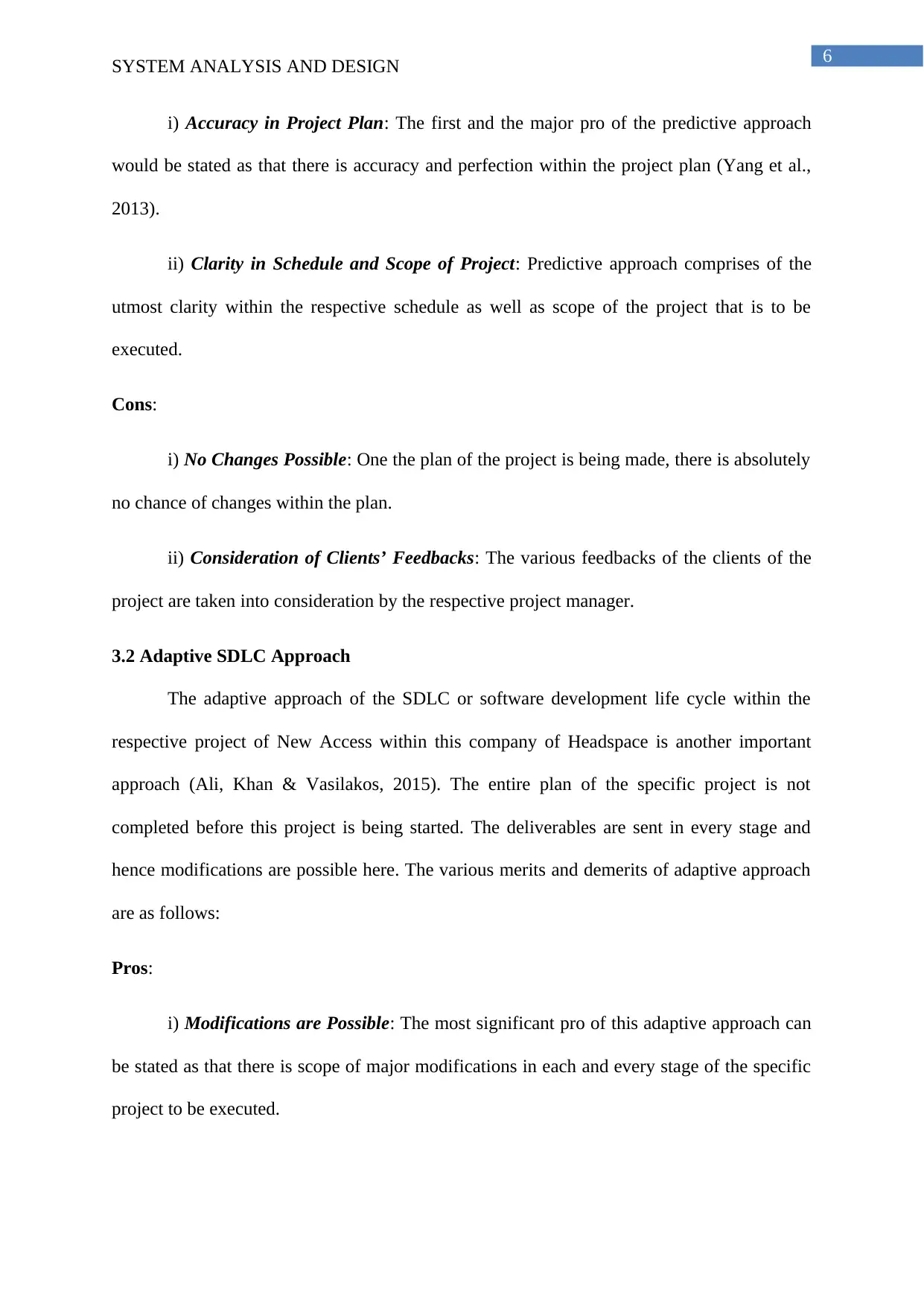
6
SYSTEM ANALYSIS AND DESIGN
i) Accuracy in Project Plan: The first and the major pro of the predictive approach
would be stated as that there is accuracy and perfection within the project plan (Yang et al.,
2013).
ii) Clarity in Schedule and Scope of Project: Predictive approach comprises of the
utmost clarity within the respective schedule as well as scope of the project that is to be
executed.
Cons:
i) No Changes Possible: One the plan of the project is being made, there is absolutely
no chance of changes within the plan.
ii) Consideration of Clients’ Feedbacks: The various feedbacks of the clients of the
project are taken into consideration by the respective project manager.
3.2 Adaptive SDLC Approach
The adaptive approach of the SDLC or software development life cycle within the
respective project of New Access within this company of Headspace is another important
approach (Ali, Khan & Vasilakos, 2015). The entire plan of the specific project is not
completed before this project is being started. The deliverables are sent in every stage and
hence modifications are possible here. The various merits and demerits of adaptive approach
are as follows:
Pros:
i) Modifications are Possible: The most significant pro of this adaptive approach can
be stated as that there is scope of major modifications in each and every stage of the specific
project to be executed.
SYSTEM ANALYSIS AND DESIGN
i) Accuracy in Project Plan: The first and the major pro of the predictive approach
would be stated as that there is accuracy and perfection within the project plan (Yang et al.,
2013).
ii) Clarity in Schedule and Scope of Project: Predictive approach comprises of the
utmost clarity within the respective schedule as well as scope of the project that is to be
executed.
Cons:
i) No Changes Possible: One the plan of the project is being made, there is absolutely
no chance of changes within the plan.
ii) Consideration of Clients’ Feedbacks: The various feedbacks of the clients of the
project are taken into consideration by the respective project manager.
3.2 Adaptive SDLC Approach
The adaptive approach of the SDLC or software development life cycle within the
respective project of New Access within this company of Headspace is another important
approach (Ali, Khan & Vasilakos, 2015). The entire plan of the specific project is not
completed before this project is being started. The deliverables are sent in every stage and
hence modifications are possible here. The various merits and demerits of adaptive approach
are as follows:
Pros:
i) Modifications are Possible: The most significant pro of this adaptive approach can
be stated as that there is scope of major modifications in each and every stage of the specific
project to be executed.
Paraphrase This Document
Need a fresh take? Get an instant paraphrase of this document with our AI Paraphraser
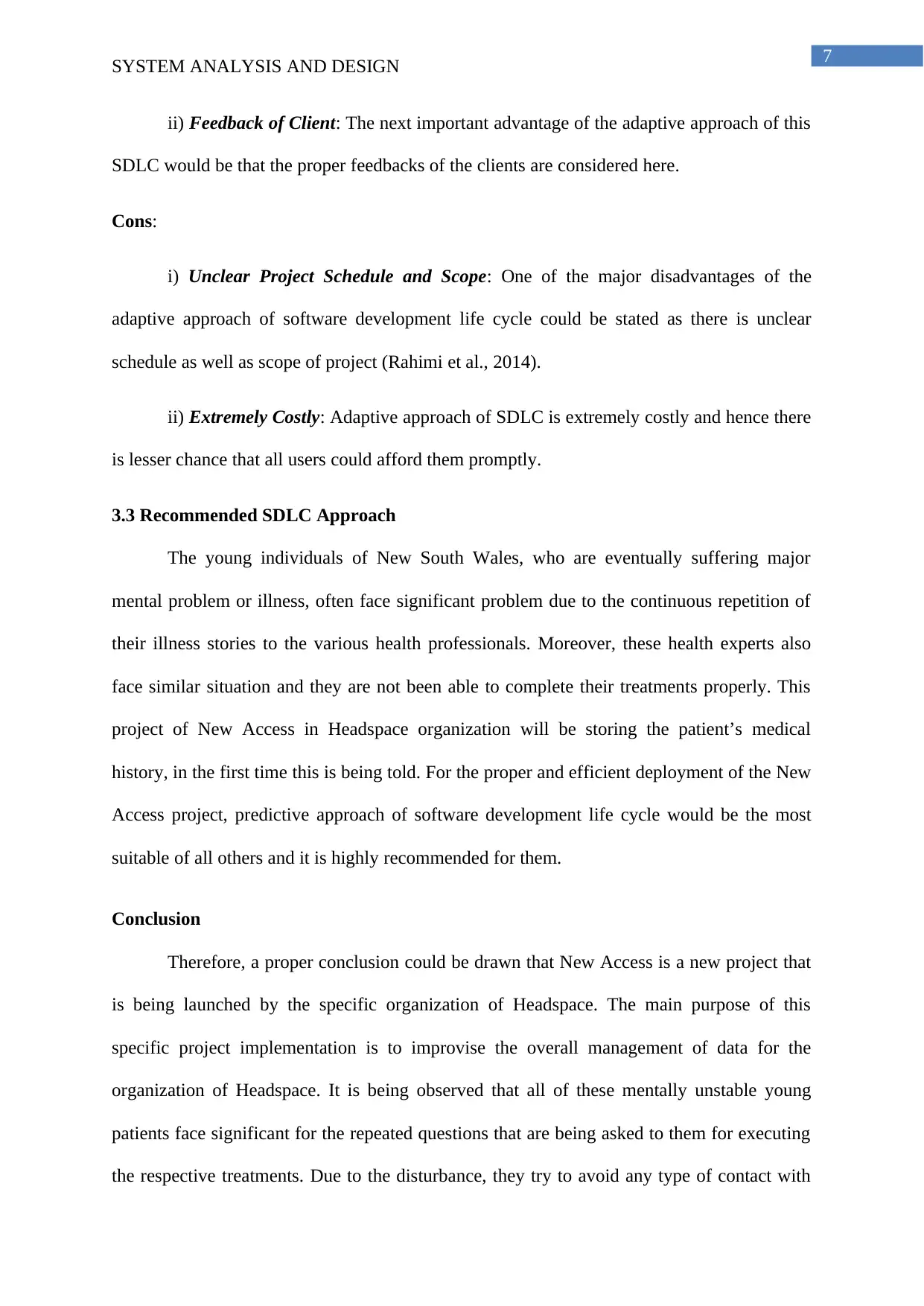
7
SYSTEM ANALYSIS AND DESIGN
ii) Feedback of Client: The next important advantage of the adaptive approach of this
SDLC would be that the proper feedbacks of the clients are considered here.
Cons:
i) Unclear Project Schedule and Scope: One of the major disadvantages of the
adaptive approach of software development life cycle could be stated as there is unclear
schedule as well as scope of project (Rahimi et al., 2014).
ii) Extremely Costly: Adaptive approach of SDLC is extremely costly and hence there
is lesser chance that all users could afford them promptly.
3.3 Recommended SDLC Approach
The young individuals of New South Wales, who are eventually suffering major
mental problem or illness, often face significant problem due to the continuous repetition of
their illness stories to the various health professionals. Moreover, these health experts also
face similar situation and they are not been able to complete their treatments properly. This
project of New Access in Headspace organization will be storing the patient’s medical
history, in the first time this is being told. For the proper and efficient deployment of the New
Access project, predictive approach of software development life cycle would be the most
suitable of all others and it is highly recommended for them.
Conclusion
Therefore, a proper conclusion could be drawn that New Access is a new project that
is being launched by the specific organization of Headspace. The main purpose of this
specific project implementation is to improvise the overall management of data for the
organization of Headspace. It is being observed that all of these mentally unstable young
patients face significant for the repeated questions that are being asked to them for executing
the respective treatments. Due to the disturbance, they try to avoid any type of contact with
SYSTEM ANALYSIS AND DESIGN
ii) Feedback of Client: The next important advantage of the adaptive approach of this
SDLC would be that the proper feedbacks of the clients are considered here.
Cons:
i) Unclear Project Schedule and Scope: One of the major disadvantages of the
adaptive approach of software development life cycle could be stated as there is unclear
schedule as well as scope of project (Rahimi et al., 2014).
ii) Extremely Costly: Adaptive approach of SDLC is extremely costly and hence there
is lesser chance that all users could afford them promptly.
3.3 Recommended SDLC Approach
The young individuals of New South Wales, who are eventually suffering major
mental problem or illness, often face significant problem due to the continuous repetition of
their illness stories to the various health professionals. Moreover, these health experts also
face similar situation and they are not been able to complete their treatments properly. This
project of New Access in Headspace organization will be storing the patient’s medical
history, in the first time this is being told. For the proper and efficient deployment of the New
Access project, predictive approach of software development life cycle would be the most
suitable of all others and it is highly recommended for them.
Conclusion
Therefore, a proper conclusion could be drawn that New Access is a new project that
is being launched by the specific organization of Headspace. The main purpose of this
specific project implementation is to improvise the overall management of data for the
organization of Headspace. It is being observed that all of these mentally unstable young
patients face significant for the repeated questions that are being asked to them for executing
the respective treatments. Due to the disturbance, they try to avoid any type of contact with

8
SYSTEM ANALYSIS AND DESIGN
their doctors and nurses. Hence, New Access would be much efficient for these young
patients. The above given report has then explained about the case study of New Access with
every non functional requirement of it. This report has also even described about various
advantages and disadvantages of a selected cloud based solution for New Access and a proper
recommended approach of software development life cycle after taking into consideration of
adaptive and predictive approaches.
SYSTEM ANALYSIS AND DESIGN
their doctors and nurses. Hence, New Access would be much efficient for these young
patients. The above given report has then explained about the case study of New Access with
every non functional requirement of it. This report has also even described about various
advantages and disadvantages of a selected cloud based solution for New Access and a proper
recommended approach of software development life cycle after taking into consideration of
adaptive and predictive approaches.
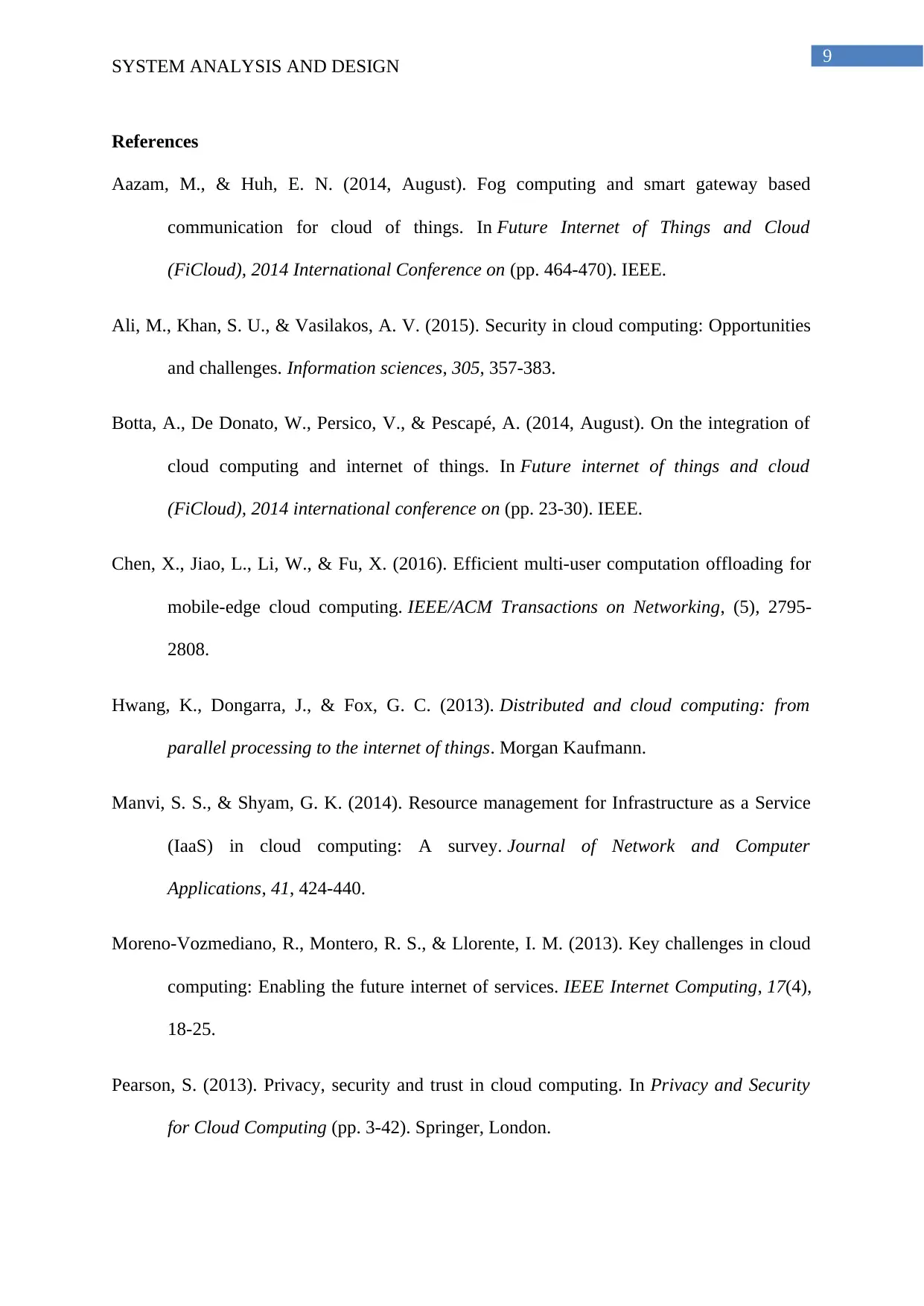
9
SYSTEM ANALYSIS AND DESIGN
References
Aazam, M., & Huh, E. N. (2014, August). Fog computing and smart gateway based
communication for cloud of things. In Future Internet of Things and Cloud
(FiCloud), 2014 International Conference on (pp. 464-470). IEEE.
Ali, M., Khan, S. U., & Vasilakos, A. V. (2015). Security in cloud computing: Opportunities
and challenges. Information sciences, 305, 357-383.
Botta, A., De Donato, W., Persico, V., & Pescapé, A. (2014, August). On the integration of
cloud computing and internet of things. In Future internet of things and cloud
(FiCloud), 2014 international conference on (pp. 23-30). IEEE.
Chen, X., Jiao, L., Li, W., & Fu, X. (2016). Efficient multi-user computation offloading for
mobile-edge cloud computing. IEEE/ACM Transactions on Networking, (5), 2795-
2808.
Hwang, K., Dongarra, J., & Fox, G. C. (2013). Distributed and cloud computing: from
parallel processing to the internet of things. Morgan Kaufmann.
Manvi, S. S., & Shyam, G. K. (2014). Resource management for Infrastructure as a Service
(IaaS) in cloud computing: A survey. Journal of Network and Computer
Applications, 41, 424-440.
Moreno-Vozmediano, R., Montero, R. S., & Llorente, I. M. (2013). Key challenges in cloud
computing: Enabling the future internet of services. IEEE Internet Computing, 17(4),
18-25.
Pearson, S. (2013). Privacy, security and trust in cloud computing. In Privacy and Security
for Cloud Computing (pp. 3-42). Springer, London.
SYSTEM ANALYSIS AND DESIGN
References
Aazam, M., & Huh, E. N. (2014, August). Fog computing and smart gateway based
communication for cloud of things. In Future Internet of Things and Cloud
(FiCloud), 2014 International Conference on (pp. 464-470). IEEE.
Ali, M., Khan, S. U., & Vasilakos, A. V. (2015). Security in cloud computing: Opportunities
and challenges. Information sciences, 305, 357-383.
Botta, A., De Donato, W., Persico, V., & Pescapé, A. (2014, August). On the integration of
cloud computing and internet of things. In Future internet of things and cloud
(FiCloud), 2014 international conference on (pp. 23-30). IEEE.
Chen, X., Jiao, L., Li, W., & Fu, X. (2016). Efficient multi-user computation offloading for
mobile-edge cloud computing. IEEE/ACM Transactions on Networking, (5), 2795-
2808.
Hwang, K., Dongarra, J., & Fox, G. C. (2013). Distributed and cloud computing: from
parallel processing to the internet of things. Morgan Kaufmann.
Manvi, S. S., & Shyam, G. K. (2014). Resource management for Infrastructure as a Service
(IaaS) in cloud computing: A survey. Journal of Network and Computer
Applications, 41, 424-440.
Moreno-Vozmediano, R., Montero, R. S., & Llorente, I. M. (2013). Key challenges in cloud
computing: Enabling the future internet of services. IEEE Internet Computing, 17(4),
18-25.
Pearson, S. (2013). Privacy, security and trust in cloud computing. In Privacy and Security
for Cloud Computing (pp. 3-42). Springer, London.
Secure Best Marks with AI Grader
Need help grading? Try our AI Grader for instant feedback on your assignments.
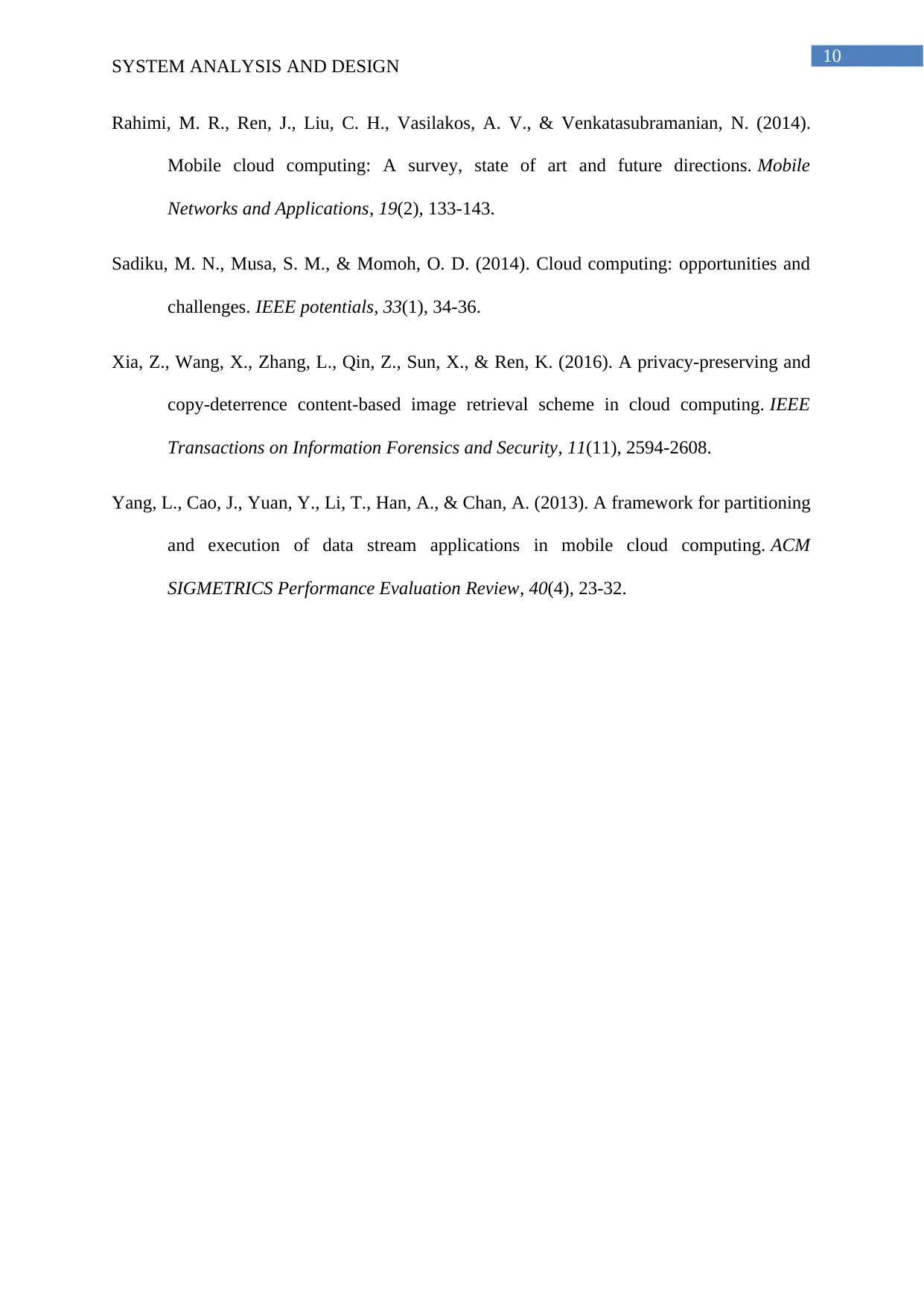
10
SYSTEM ANALYSIS AND DESIGN
Rahimi, M. R., Ren, J., Liu, C. H., Vasilakos, A. V., & Venkatasubramanian, N. (2014).
Mobile cloud computing: A survey, state of art and future directions. Mobile
Networks and Applications, 19(2), 133-143.
Sadiku, M. N., Musa, S. M., & Momoh, O. D. (2014). Cloud computing: opportunities and
challenges. IEEE potentials, 33(1), 34-36.
Xia, Z., Wang, X., Zhang, L., Qin, Z., Sun, X., & Ren, K. (2016). A privacy-preserving and
copy-deterrence content-based image retrieval scheme in cloud computing. IEEE
Transactions on Information Forensics and Security, 11(11), 2594-2608.
Yang, L., Cao, J., Yuan, Y., Li, T., Han, A., & Chan, A. (2013). A framework for partitioning
and execution of data stream applications in mobile cloud computing. ACM
SIGMETRICS Performance Evaluation Review, 40(4), 23-32.
SYSTEM ANALYSIS AND DESIGN
Rahimi, M. R., Ren, J., Liu, C. H., Vasilakos, A. V., & Venkatasubramanian, N. (2014).
Mobile cloud computing: A survey, state of art and future directions. Mobile
Networks and Applications, 19(2), 133-143.
Sadiku, M. N., Musa, S. M., & Momoh, O. D. (2014). Cloud computing: opportunities and
challenges. IEEE potentials, 33(1), 34-36.
Xia, Z., Wang, X., Zhang, L., Qin, Z., Sun, X., & Ren, K. (2016). A privacy-preserving and
copy-deterrence content-based image retrieval scheme in cloud computing. IEEE
Transactions on Information Forensics and Security, 11(11), 2594-2608.
Yang, L., Cao, J., Yuan, Y., Li, T., Han, A., & Chan, A. (2013). A framework for partitioning
and execution of data stream applications in mobile cloud computing. ACM
SIGMETRICS Performance Evaluation Review, 40(4), 23-32.
1 out of 11
Related Documents
Your All-in-One AI-Powered Toolkit for Academic Success.
+13062052269
info@desklib.com
Available 24*7 on WhatsApp / Email
![[object Object]](/_next/static/media/star-bottom.7253800d.svg)
Unlock your academic potential
© 2024 | Zucol Services PVT LTD | All rights reserved.




